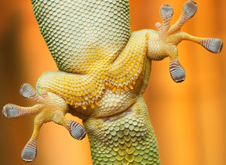Home > Press > Replicating a sticky situation in nature
 |
| Geckos can move on virtually all surfaces, vertical and horizontal, due to their foot pads. Photo by iStock. |
Abstract:
Inspired by the ease with which gecko lizards can move on almost any surface, researchers at Northeastern University, the Korea Institute of Science and Technology and Seoul National University hope to reproduce properties found in the gecko's footpad for applications ranging from adhesives to robotic movement and navigation.
Replicating a sticky situation in nature
Boston, MA | Posted on July 5th, 2010The team, led by Ashkan Vaziri, assistant professor of mechanical and industrial engineering at Northeastern, and Myoung-Woon Moon, of the Korea Institute of Science and Technology, created nanoscale and microscale patterned surfaces with adhesion and friction properties similar to that of the gecko footpad.
The innovative methodology, published online and in the academic journal Soft Matter, could lead to the development of a "smart" adhesive that adapts to environmental stimuli, such as a curvy surface or a rough edge.
"The gecko footpad's unique structure and function make it one of the most efficient adhesion systems found in nature," said Vaziri, who also directs Northeastern's High Performance Materials and Structures Laboratory.
Gecko toes are covered by millions of hair-like structures called setae, each of which is five micrometers in size — smaller than a human hair. The ends of the setae are tipped with hundreds of spatula, which bend and conform to the surface on which the gecko is moving. These properties help geckos move robustly on virtually all vertical and horizontal surfaces.
The research team designed and created a series of micropillars, or hair-like structures, and exposed them to ion beam radiation. The radiation tilted the micropillars, resulting in a dual-surface area with unique adhesion and friction properties.
Through a series of experiments, the team found that the micropillars had qualitatively similar friction properties and function when compared to the gecko footpad.
"If equipped with micropillars, small high-tech robots [for research or military applications] might be able to climb with speed, precision and accuracy on uneven, slippery surfaces," said Vaziri.
The technology also could lead to a new generation of smart adhesives that are equipped to hold strong bonds with any surface, he said.
####
For more information, please click here
Contacts:
Jenny Catherine Eriksen
617-373-2802
Copyright © Northeastern University
If you have a comment, please Contact us.Issuers of news releases, not 7th Wave, Inc. or Nanotechnology Now, are solely responsible for the accuracy of the content.
| Related News Press |
News and information
![]() Researchers develop molecular qubits that communicate at telecom frequencies October 3rd, 2025
Researchers develop molecular qubits that communicate at telecom frequencies October 3rd, 2025
![]() Next-generation quantum communication October 3rd, 2025
Next-generation quantum communication October 3rd, 2025
![]() "Nanoreactor" cage uses visible light for catalytic and ultra-selective cross-cycloadditions October 3rd, 2025
"Nanoreactor" cage uses visible light for catalytic and ultra-selective cross-cycloadditions October 3rd, 2025
Possible Futures
![]() Spinel-type sulfide semiconductors to operate the next-generation LEDs and solar cells For solar-cell absorbers and green-LED source October 3rd, 2025
Spinel-type sulfide semiconductors to operate the next-generation LEDs and solar cells For solar-cell absorbers and green-LED source October 3rd, 2025
Academic/Education
![]() Rice University launches Rice Synthetic Biology Institute to improve lives January 12th, 2024
Rice University launches Rice Synthetic Biology Institute to improve lives January 12th, 2024
![]() Multi-institution, $4.6 million NSF grant to fund nanotechnology training September 9th, 2022
Multi-institution, $4.6 million NSF grant to fund nanotechnology training September 9th, 2022
Announcements
![]() Rice membrane extracts lithium from brines with greater speed, less waste October 3rd, 2025
Rice membrane extracts lithium from brines with greater speed, less waste October 3rd, 2025
![]() Researchers develop molecular qubits that communicate at telecom frequencies October 3rd, 2025
Researchers develop molecular qubits that communicate at telecom frequencies October 3rd, 2025
![]() Next-generation quantum communication October 3rd, 2025
Next-generation quantum communication October 3rd, 2025
![]() "Nanoreactor" cage uses visible light for catalytic and ultra-selective cross-cycloadditions October 3rd, 2025
"Nanoreactor" cage uses visible light for catalytic and ultra-selective cross-cycloadditions October 3rd, 2025
Research partnerships
![]() Lab to industry: InSe wafer-scale breakthrough for future electronics August 8th, 2025
Lab to industry: InSe wafer-scale breakthrough for future electronics August 8th, 2025
![]() HKU physicists uncover hidden order in the quantum world through deconfined quantum critical points April 25th, 2025
HKU physicists uncover hidden order in the quantum world through deconfined quantum critical points April 25th, 2025
|
|
||
|
|
||
| The latest news from around the world, FREE | ||
|
|
||
|
|
||
| Premium Products | ||
|
|
||
|
Only the news you want to read!
Learn More |
||
|
|
||
|
Full-service, expert consulting
Learn More |
||
|
|
||








